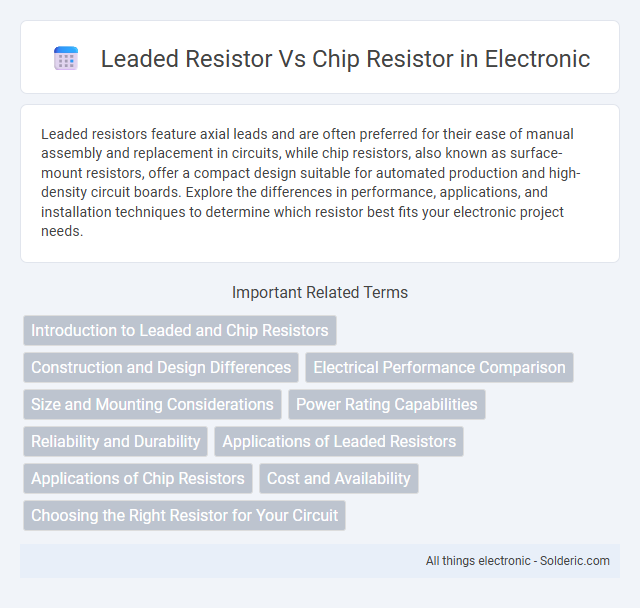Leaded resistors feature axial leads and are often preferred for their ease of manual assembly and replacement in circuits, while chip resistors, also known as surface-mount resistors, offer a compact design suitable for automated production and high-density circuit boards. Explore the differences in performance, applications, and installation techniques to determine which resistor best fits your electronic project needs.
Comparison Table
| Feature | Leaded Resistor | Chip Resistor |
|---|---|---|
| Package Type | Axial leads | Surface mount device (SMD) |
| Mounting | Through-hole | Surface mount technology (SMT) |
| Size | Larger, bulkier | Compact, miniature |
| Power Rating | Typically 0.25W to 5W | Typically 0.063W to 1W |
| Tolerance | +-1% to +-5% | +-0.1% to +-5% |
| Frequency Response | Lower frequency range | Better high frequency characteristics |
| Cost | Higher assembly cost | Lower assembly cost |
| Applications | Prototyping, high power circuits | High-density PCBs, mass production |
Introduction to Leaded and Chip Resistors
Leaded resistors feature axial wire leads for easy insertion into breadboards and through-hole PCBs, making them ideal for prototyping and high-power applications. Chip resistors, also known as surface-mount resistors, are compact, designed for automated assembly on surface-mount technology (SMT) PCBs, enabling higher circuit density and improved performance at high frequencies. Your choice between leaded and chip resistors depends on factors like manufacturing methods, space constraints, and electrical requirements.
Construction and Design Differences
Leaded resistors feature wire leads extending from a cylindrical or rectangular resistive element encased in a ceramic or metal oxide body, allowing easy through-hole mounting on circuit boards. Chip resistors, also called surface-mount resistors, are constructed as compact, rectangular ceramic substrates coated with resistive film and metal terminals on either end, designed for direct placement onto printed circuit boards (PCBs). The chip resistor's miniature size and flat design enable high-density automated assembly, while leaded resistors offer mechanical strength and easy circuit prototyping through lead wires.
Electrical Performance Comparison
Leaded resistors generally offer higher power dissipation and better tolerance to thermal stress compared to chip resistors, making them suitable for high-voltage and high-current applications. Chip resistors provide superior frequency response and lower parasitic inductance, which enhances performance in high-frequency circuits and precise signal processing. Your choice should consider the specific electrical requirements, such as power rating, tolerance, and frequency response, to optimize circuit reliability and efficiency.
Size and Mounting Considerations
Leaded resistors typically have larger sizes with axial or radial leads, making them suitable for through-hole mounting on printed circuit boards (PCBs), which provides strong mechanical stability but requires more space. Chip resistors are surface-mount devices (SMD) with compact rectangular packages designed for automated placement on PCB surfaces, offering significant space savings and enabling high-density circuit designs. Your choice depends on PCB layout constraints and assembly methods, balancing size requirements and mounting preferences for efficient circuit integration.
Power Rating Capabilities
Leaded resistors typically have higher power rating capabilities, ranging from 0.25 watts to several watts, making them suitable for applications requiring heat dissipation and durability. Chip resistors usually have lower power ratings, commonly between 0.063 watts and 0.5 watts, limiting their use to low-power circuits. The physical size and construction of leaded resistors contribute to better thermal management compared to the compact and surface-mount design of chip resistors.
Reliability and Durability
Leaded resistors generally offer greater durability due to their robust physical construction and better heat dissipation, making them suitable for high-stress environments. Chip resistors, while compact and ideal for automated assembly, may exhibit lower reliability under extreme mechanical or thermal stress because of their smaller size and surface-mount design. The choice between leaded and chip resistors depends heavily on the application's operational conditions and longevity requirements.
Applications of Leaded Resistors
Leaded resistors are widely used in applications requiring higher power dissipation, such as power supplies, audio equipment, and industrial machinery, where their robust design ensures durability and reliable performance under stress. Their axial leads make them suitable for through-hole mounting on printed circuit boards (PCBs), providing ease of manual assembly and replacement in prototyping or repair scenarios. Compared to chip resistors, leaded resistors are favored when mechanical stability and heat dissipation are critical, making them ideal for circuits exposed to physical vibrations or higher operating temperatures.
Applications of Chip Resistors
Chip resistors are widely used in high-density electronic circuits such as smartphones, laptops, and medical devices due to their compact size and surface-mount technology compatibility. Their small footprint enables automated assembly processes, enhancing production efficiency in mass manufacturing of consumer electronics and industrial equipment. High-frequency applications and precise signal control in telecommunications also benefit from chip resistors' minimal parasitic inductance and capacitance.
Cost and Availability
Leaded resistors generally offer lower initial costs and are widely available through traditional electronic component suppliers, making them suitable for low-volume or prototype projects. Chip resistors, made with surface-mount technology, tend to be more cost-effective for high-volume manufacturing due to automated assembly processes and smaller size, which reduces material costs. Supply chain stability favors chip resistors, as their demand aligns with modern electronics production, ensuring better availability in large quantities.
Choosing the Right Resistor for Your Circuit
Choosing the right resistor for your circuit depends on factors like size, power rating, and mounting style. Leaded resistors offer easy manual soldering and higher power dissipation, making them ideal for prototyping and circuits requiring robust thermal management. Chip resistors, compact with surface-mount technology (SMT), suit high-density PCB layouts and automated assembly, optimizing space and reliability in modern electronics.
Leaded resistor vs chip resistor Infographic

 solderic.com
solderic.com